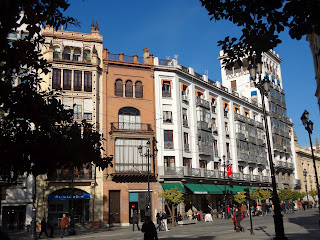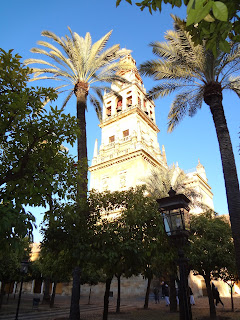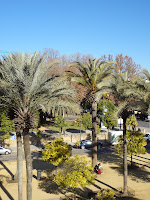We started the morning with a visit to the Cathedral, and then we realized it wasn't fully open because mass was going on. So we decided to explore the city in the morning and then in the afternoon we would go back to the cathedral and tour it.
We ended up getting some breakfast (tortilla española on a sandwich) and then wandering the city for a bit until we came upon the Plaza de Toros, more commonly known as the bullfighting ring! We enjoyed the sights of the Guadalquivir River. It's one of the largest rivers in Spain, going through both Córdoba and Sevilla.
These are just some photos from walking around the city - it's a really beautiful city! Lots of sun, palm trees, orange trees, and beauty all jam packed into one great city!
Here's some more Andalusian beauty!

Here is one of the first views of the cathedral we had. It holds two titles: the largest gothic style cathedral, as well as the 3rd largest Cathedral in the world. It's home to Christopher Columbus' remains, as well as a thorn from Jesus' crown of thorns.
This is the beautiful stained glass located inside of the doors of the cathedral. The sun was shining in the window just right to cast a glow on the wall from the stained glass!
As I said before, we found the Plaza de Toros - here it is! It's where countless bullfights have occurred. It's the oldest bullring in Spain!
And here is the great river, the Guadalquivir! It's one of the largest rivers in Spain, and in Sevilla there was a really beautiful park right next to the river. At the end of the park, we found the following monument, called the Torre de Oro (Tower of Gold).
 This is the Torre de Oro, and it's so named because it used to have little flecks of gold all over it, so that when the sun was shining, ships out at sea could see the reflection and use it to navigate up the river. The river was used as a major way to get silver from the newly discovered America back to Spain, and there were a lot of imports. There used to be an identical tower across the river from this one, but this one is the only one remaining.
This is the Torre de Oro, and it's so named because it used to have little flecks of gold all over it, so that when the sun was shining, ships out at sea could see the reflection and use it to navigate up the river. The river was used as a major way to get silver from the newly discovered America back to Spain, and there were a lot of imports. There used to be an identical tower across the river from this one, but this one is the only one remaining. This is a photo of Christopher Columbus' tomb within the cathedral. It's said that only a small part of his "remains" are here. Once he died, his remains were shipped to Santo Domingo (now in the Dominican Republic). As time went on, and as the island of Hispanola became less important to the Spanish Empire. In 1795, Hispanola was ceded to the French as part of a peace treaty. Not wanting the precious bones of Columbus to fall into French hands, they shipped the bones to Havana, Cuba. In 1898, Spain was at war with the United States, and the remains were sent back to Spain, lest they fall into the hands of the Americans. However, since then, in the Dominican Republic, a group of workers discovered a box of bones in the Cathedral inscribed with, "Illustrious and distinguished male, don Cristobal Colon". The people of the Dominican Republic believe that in 1795, the Spaniards shipped the wrong body out of the Dominican Republic. They believe that they now have the real remains of Christopher Columbus, meanwhile, Spain believes they have the real remains. DNA testing was done on the bones of the body in Spain (which revealed a VERY similar match to Columbus' brother) but in the Dominican Republic, the people do not want a DNA test, as they don't want to find out that they don't have the right body. So...nobody actually knows where the correct bones are of Christopher Columbus. There's a fun story for you!
Here's a photo of the cathedral as we were climbing up La Giralda. (a muslim tower remaining outside of the patio at the cathedral - 36 ramps later, you get the most amazing views of the city.)
Such as this one! :)
And this is the tower, La Giralda.
And finally, to conclude our trip to Sevilla, I will include what is supposed to be a thorn from Jesus' crown of thorns. It's in the Cathedral in Sevilla.
Do you believe it's an actual relic?
:)
Besos y abrazos!
Erin































